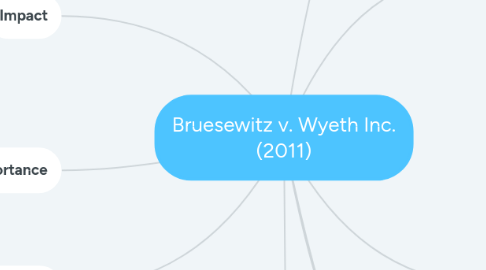
1. Impact
1.1. Milik v. Secretary of Health and Human Services (2016)
1.1.1. Parents petitioned for compensation under NCVIA for severe neurologic damage to their son following an MMR vaccine.
1.1.1.1. Petition was denied, and the parents appealed.
1.1.1.1.1. Miliks argued that the NCVIA was unconstitutional and cited the Bruesewitz's case.
1.2. Holmes v. Merck & Co., Inc. (2012)
1.2.1. Parents filed action against Merck for negligence, strict product liability, negligent design, failure to warn, misrepresentation, express warranty, implied warranty of merchantability, implied warranty of fitness for a particular purpose, and punitive damages.
1.2.1.1. The US District Court of Nevada found in favor of the manufacturer.
1.2.1.1.1. Parents appealed.
2. Importance
2.1. As a business professional, this case helps reiterate the importance of awareness of product liability, including design, manufacturing, and marketing.
3. Influence
3.1. If Wyeth had lost the case, most drug manufacturers would not be able to afford to stay in business.
3.2. Parents may be less willing to vaccinate their children if they know they will be unable to win a case against the manufacturer.
4. Facts
4.1. Parties
4.1.1. Russell and Robalee Bruesewitz (daughter Hannah)
4.2. What happened
4.2.1. Hannah Bruesewitz developed seizures 2 hrs after receiving her 6 month diphtheria, tetanus, pertussis vaccine (1992).
4.2.2. Hannah was hospitalized for weeks.
4.2.3. Hannah continued to have seizures and require constant care.
4.2.4. One month before the petition, seizure was removed from the list of compensable injuries as a result of new regulations.
4.2.5. In 1998, Wyeth removed this vaccine from the market.
4.3. Procedural history
4.3.1. When Hannah was 3yo, her parents filed a petition for compensation for her injuries in the Court of Federal Claims.
4.3.1.1. Petition was denied.
4.3.2. Bruesewitzes filed a lawsuit against Wyeth (Pennsylvania state court)
4.3.2.1. Claim: Liability and liability for negligent design by failing to develop a safe vaccine and should be accountable for a defective vaccine design that caused preventable injuries.
4.3.2.1.1. Federal judge dismissed the suit due to National Childhood Vaccine Injury Act.
4.3.3. US Court of Appeals (3rd circuit)
4.3.3.1. Affirmed the decision.
5. Issue before the court
5.1. Is the vaccine manufacturer liable for the injuries to Hannah?
6. Rule of Law
6.1. National Childhood Vaccine Injury Act of 1976 (NCVIA) 42 U.S.C § 300aa-22(b)(1)
6.1.1. Established a compensation program in place of judicial action for mandated vaccine-related injuries (Source: 1)
6.2. Product liability law
6.2.1. 3 grounds for liability include design defects, manufacturing defects, and marketing defects
7. Analysis/Application
7.1. Wyeth
7.1.1. NCVIA protects Wyeth from civil action for damages related to vaccine administration as long as the vaccine was properly prepared and had proper directions/warnings.
7.1.1.1. NCVIA helps keep vaccine manufacturers from closing as a result of tort lawsuits.
7.1.1.1.1. The drug manufacturers fund compensation program for those injured as a result of vaccines.
7.2. Breusewitz
7.2.1. Used design defect as their basis for suit.
7.2.1.1. Design defect = "Foreseeable risk posed by the product when the product was manufactured as intended and used for its intended purposes." (Source: 2)
7.2.1.1.1. Many states also require plaintiff to show risk could have been avoided by a reasonable alternative design that is able to be produced, is economically possible to produce, and does not change the product's function. (Source: 2)
8. Conclusion
8.1. Supreme Court affirmed the lower courts decision in favor of Wyeth.
8.1.1. NCVIA prevents drug design claims against manufacturers for injury as a result of a vaccine.
8.1.1.1. Most of the Justices reasoned there is a special vaccine court in place to compensate injured persons; this allows drug manufacturers to remain in business.
